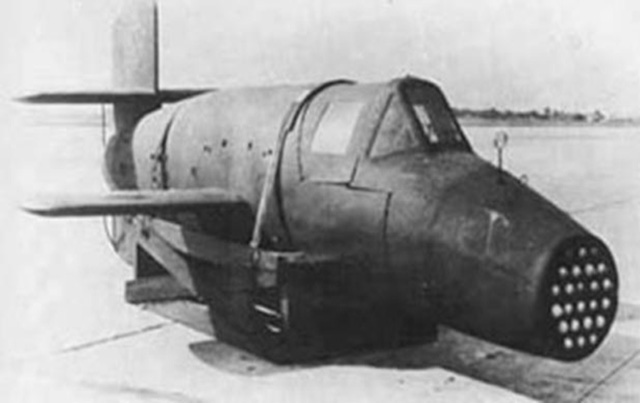
1944 Bachem Natter Viper
Developed in the closing stages of World War II, this was one of the X-type projects attempted by Germany.
Constructed of wood in 250 man-hours with unskilled labor, the Ba 349 Natter was designed to be launched vertically when enemy bomber formations were sighted in the area. Initial gliding tests were performed in 1944 by dropping the test aircraft from a Heinkel He-111 bomber at 18,000 feet. The test pilot attained a speed of 425 mph, and controllability was excellent down to speeds of 125 mph. Roll and pitch control was designed to be accomplished by use of the elevons at the rear of the aircraft. Because there was no landing gear, the pilot bailed out when the tests were complete.
In a combat operation the liquid-fueled Walter rocket engine would be started first. After technicians confirmed that all was ready, the engine was powered up and the aircraft was launched with the lighting of the four external booster rockets. With only four minutes of fuel, the initial rate of climb was over 37,000 feet per minute! The pilot, experiencing tremendous acceleration, hung on while the Natter was ground-guided until the external boosters burned out. At that point, the pilot would then take over. His job was to line up as many bombers as possible and launch the 24 rockets housed in the nose of the aircraft.
Specifications
- Year Built — 1944-45 (orginal); 2000 (replica)
- Wingspan — 13’1.5″
- Top Speed — 618 mph
- Gross Weight — 3,900 lbs (with no external boosters)
- Engine —Walter 509-C liquid rocket; Four Schmiddling external solid rocket boosters
Kermit’s Comments
After a short flight of less than 10 minutes, the Natter would run out of fuel. The pilot would then unbuckle his seat belt, pull a handle that would detach the nose of the aircraft, and deploy a parachute attached to the rear of the aircraft in an attempt to save the valuable engine for re-use. After the rear parachute opened, the pilot would be thrown out the front of the aircraft, left to save himself with his own parachute!
While there are some original parts in this aircraft, most of it has been newly manufactured.